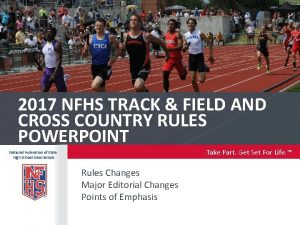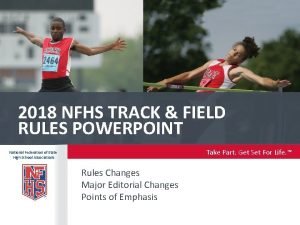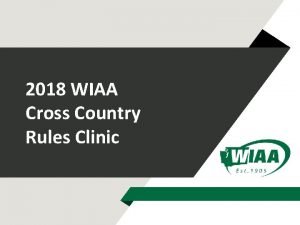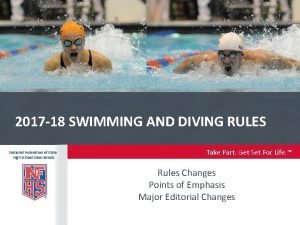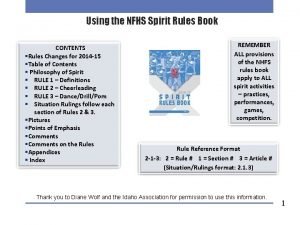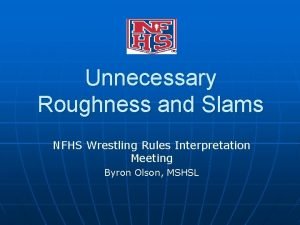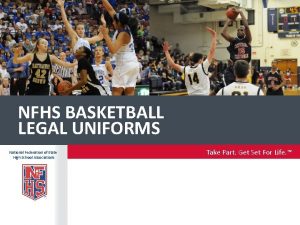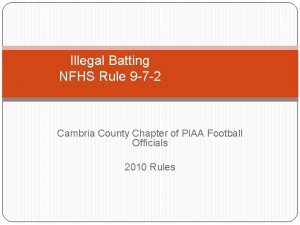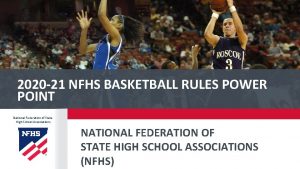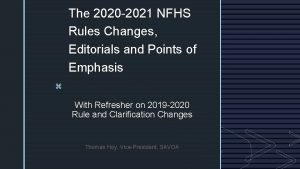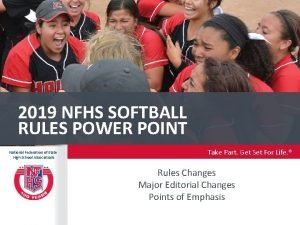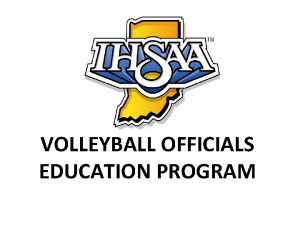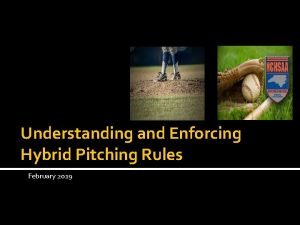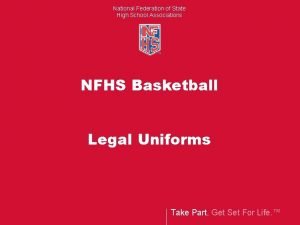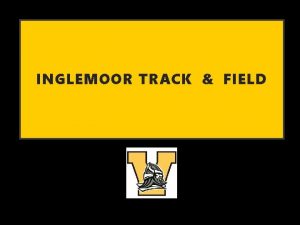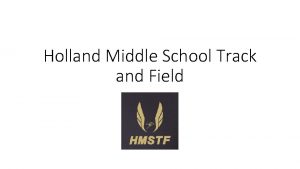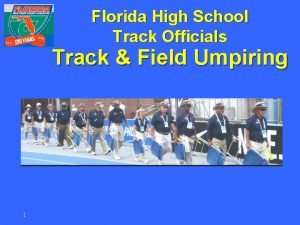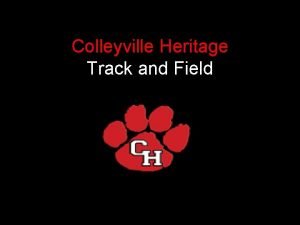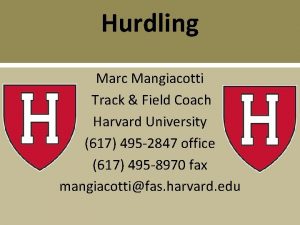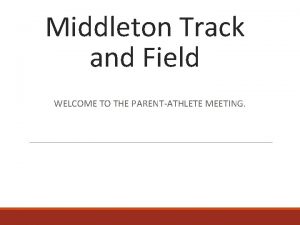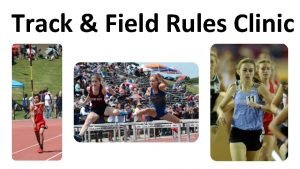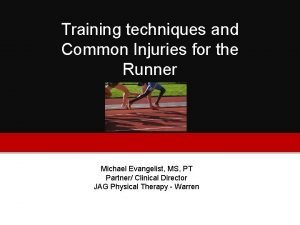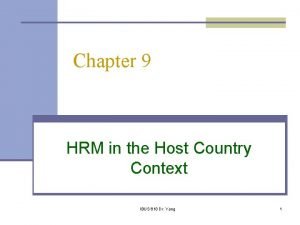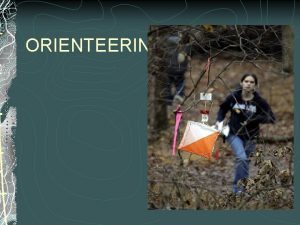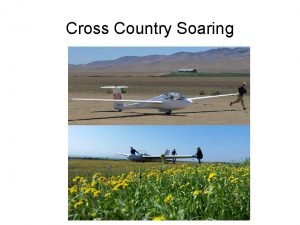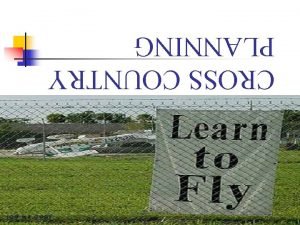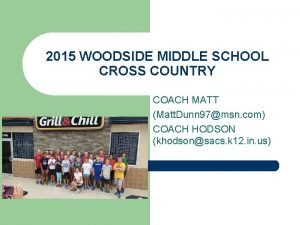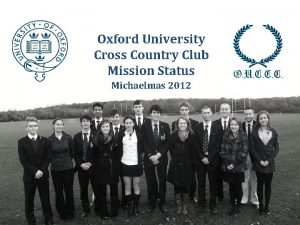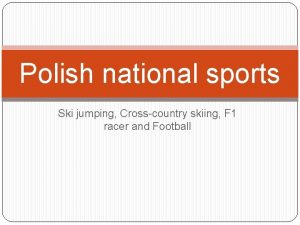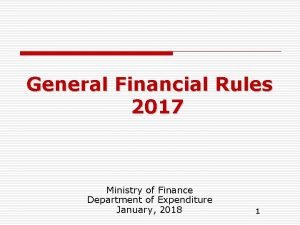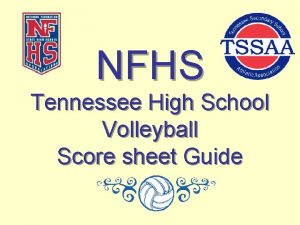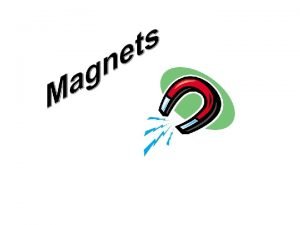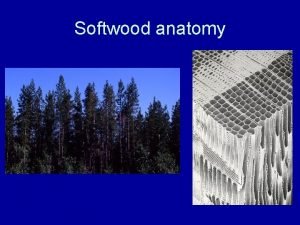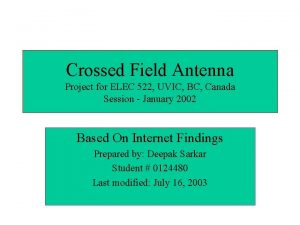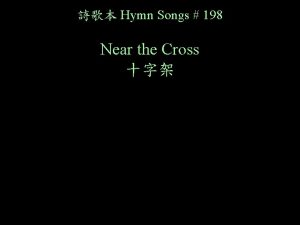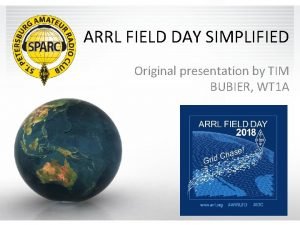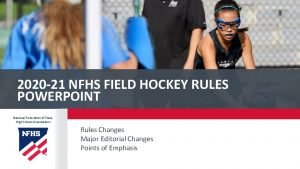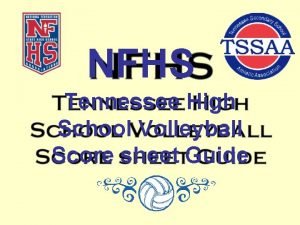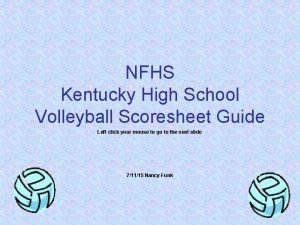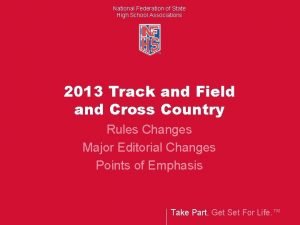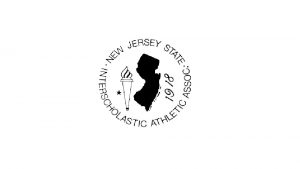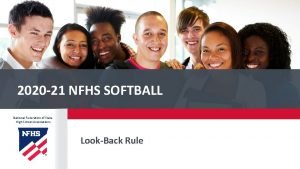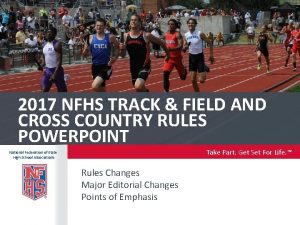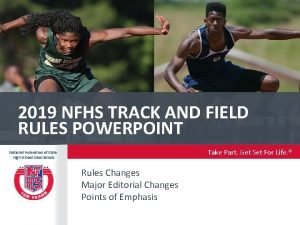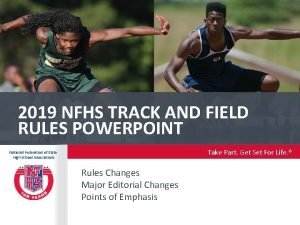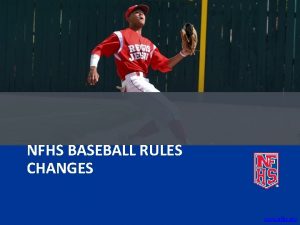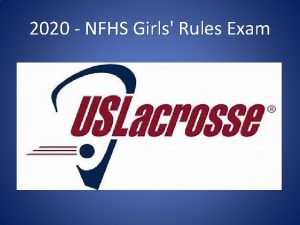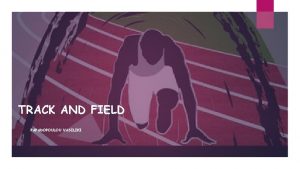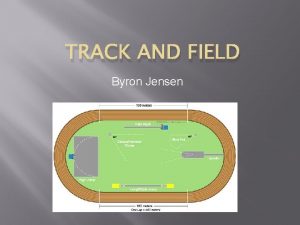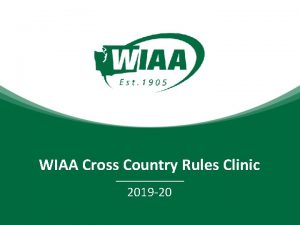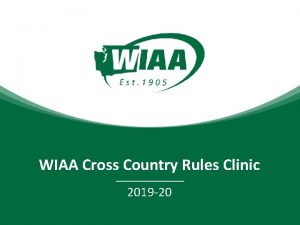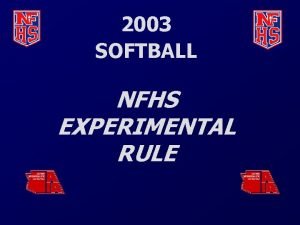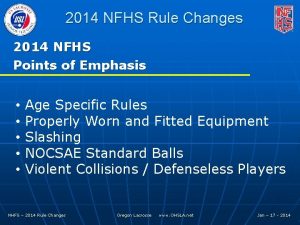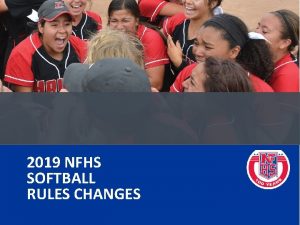2017 NFHS TRACK FIELD AND CROSS COUNTRY RULES


































































- Slides: 66

2017 NFHS TRACK & FIELD AND CROSS COUNTRY RULES POWERPOINT Take Part. Get Set For Life. ™ National Federation of State High School Associations Rules Changes Major Editorial Changes Points of Emphasis

NATIONAL FEDERATION OF STATE HIGH SCHOOL ASSOCIATIONS § NFHS (located in Indianapolis, IN – Est. 1920): • National leadership organization for high school sports and fine arts activities; • National authority on interscholastic activity programs. • Conducts national meetings; • Sanctions interstate events; • Produces national publication for high school administrators; • National source for interscholastic coach training and national information center. www. nfhs. org

NATIONAL FEDERATION OF STATE HIGH SCHOOL ASSOCIATIONS § Membership = 50 member state associations and D. C. § NFHS reaches more than 19, 000 high schools and 12 million participants in high school activity programs, including more than 7. 8 million in high school sports. www. nfhs. org

NFHS RULES REVIEW COMMITTEE The NFHS Rules Review Committee is chaired by the chief operating officer and composed of all rules editors. After each committee concludes its deliberations and has adopted its recommended changes for the subsequent year, such revisions will be evaluated by the Rules Review Committee. Davis Whitfield Chief Operating Officer Bob Colgate Football and Sports Medicine Sandy Searcy Softball and Swimming & Diving Elliot Hopkins Baseball and Wrestling Mark Koski Field Hockey Becky Oakes Cross Country, Gymnastics, Volleyball and Track & Field James Weaver Boys and Girls Lacrosse and Spirit Theresia Wynns Basketball and Soccer Dan Schuster Ice Hockey www. nfhs. org

NATIONAL FEDERATION OF STATE HIGH SCHOOL ASSOCIATIONS § The NFHS writes playing rules for 17 sports for boys and girls at the high school level. • Publishes 4 million pieces of materials annually. www. nfhs. org

NFHS RULES BOOK AS E-BOOKS § E-books features: • Searchable • Highlight areas of interest • Make notes • Desktop laptop availability • Easy navigation • Adjustable viewing size • Immediate availability www. nfhs. org

GUIDELINES FOR SCHOOLS AND STATE ASSOCIATIONS FOR CONSIDERATION OF ACCOMMODATIONS

Rules Changes NFHS TRACK & FIELD AND CROSS COUNTRY


Rule Change GAMES COMMITTEE RESPONSIBILITY RULE 3 -2 -4 u § The games committee has numerous responsibilities § The responsibility for securing and providing liquids during competition is one such responsibility § Providing liquids should not be left up to individual coaches

Rule Change SIGNALING LAST LAP RULES 3 -4 -7 AND 3 -6 -1 § Signaling the last lap now occurs in all races consisting of two laps or more § Signals Used and When • When to signal—Outdoors – For any race two laps or longer, signal at the beginning of the last lap • When to signal—Indoors (Assuming a 200 Meter Track) – For any race 400 meters or longer, signal at the beginning of the last lap www. nfhs. org

Rule Change SIGNALING LAST LAP RULES 3 -4 -7 AND 3 -6 -1 • What to use – A bell is the preferred signal; if no bell is available, a starting device or other noise maker, is used www. nfhs. org

Rule Change AUTHORITY OF REFEREE RULE 3 -6 -1 § The referee has the sole authority for ruling on infractions, except as provided in Rule 3 -6 -1. The referee has the sole authority for ruling on irregularities not covered within the rules. The referee may. . . § The exception, Rule 3 -6 -1, states the starter charging a competitor with a false start is disqualifying the competitor from that event

Rule Change STARTER’S RESPONSIBILITIES RULES 3 -6 -1, 3 -4 -7 § The starter, or any other official designated by the starter, shall give a signal at the beginning of the last lap in each individual race of two laps or more. § The starter, charging a competitor with a false start, is disqualifying the competitor from the event. www. nfhs. org

Rule Change FIELD JUDGES MECHANICS – VERBAL INDICATION OF PERFORMANCE RESULTS: RULE 3 -10 -7 § The use of flags by the head event judge is the preferred mechanic for signaling the result of the competitor’s performance § It is acceptable to use verbal indication for the result of the performance § In the absence of flags, “fair” or “foul” shall be called § Using the term “mark” is no longer appropriate www. nfhs. org

Rule Change COMPETITORS UNIFORM RULES 4 -3 -1 b(5); 8 -6 -1 b(4) § Removes the previous NOTE from both rules which was in conflict with rules 4 -3 -1 b(5) and 8 -6 -1 b(4) § One American flag, not to exceed 2 inches by 3 inches, may be worn or occupy space on each item of uniform apparel www. nfhs. org

Rule Change RECEIVING ASSISTANCE – ILL/INJURED ATHLETE RULES 4 -6 -5 g and 8 -7 e § It is an unfair act when a competitor receives any assistance. Assistance includes: • A competitor receiving assistance from another competitor to complete the race • When this occurs both competitors shall be disqualified – EXCEPTION: A competitor is injured or becomes ill and an appropriate health-care professional is not available, only the injured/ill competitor is disqualified – Every attempt should be made for the appropriate health-care professionals to make these decisions to assist www. nfhs. org

Rule Change RECEIVING ASSISTANCE AND DISQUALIFICATION RULE 8 -7 e § A competitor is disqualified who: • (e) Receives assistance from another competitor to complete the race – Both competitors shall be disqualified unless a competitor is injured or becomes ill and an appropriate health care professional is not available, only the injured/ill competitor is disqualified • Every attempt should be made for the appropriate health-care professionals to make these decisions as to assistance. www. nfhs. org

Rule Change RECEIVING ASSISTANCE AND DISQUALIFICATION 4 -6 -5 h § It is an unfair act when a competitor receives any assistance. Assistance includes: § Receiving physical aid during a race or trial from any other person • “Any other person” clarifies that not only the actions of competitors and nonparticipating team members may be considered as providing assistance but any other party is also included, such as a spectator. www. nfhs. org

Rule Change TRACK CONSTRUCTION – USE OF CONES RULE 5 -1 -3 § On all-weather tracks, a painted line meeting certain specifications may be used to mark the inner edge of the track § A raised curb meeting certain specifications is a second option to mark the inner edge of the track § In the absence of a curb, if cones are used to indicate the inner edge of the track, those cones should just touch the inside of the line and be spaced about 1. 5 meters (5 feet) apart around the curve www. nfhs. org

Rule Change FORMING HEATS FORMER RULE 5 -6 -4 DELETED § The games committee will assign the seeded contestants to the preferred lanes § When setting up heats based solely on qualifying times, rank contestants according to times, determine number of preliminary heats and follow this procedure…(Example in rules book) § Deleted the requirement that in first round competition if two contestants from the same team fall within the same heat, the slower contestant is moved to another heat www. nfhs. org

Rule Change THE START RULE 5 -7 -3 § The starting command for individual races, or opening relay legs of 800 meters or more outdoors and 600 meters or more indoors • Starter shall ask all competitors to take a position three meters behind the starting line or dashed arc behind the line § With command “On your marks” all competitors step to the starting line without delay § When all competitors are steady and motionless without their hands touching to the ground, the starter shall fire the starting device www. nfhs. org

Rule Change FIELD EVENTS RULE 6 § Previous Rule 6, Throwing Events, and Rule 7, Jumping Events are now combined into one rule § Rule 6 is now Field Events § This change avoids duplicity in the rules, removes unnecessary language and presents field event rules in a more concise manner www. nfhs. org

Rule Change FIELD EVENTS RULE 6 § Definitions are located in Section 1 Trial/Attempt Throwing events Flight Pass Horizontal events Qualify Vertical events Foul § General rules for all field events are located in Section 2, Articles 1 through 16 and 21 § Section 2, Articles 17 through 20 apply to horizontal jumps and throws § General rules for the vertical jumps, high jump and pole vault, are covered in Articles 22 through 25 www. nfhs. org

Rule Change FIELD EVENTS RULE 6 Breaking ties is addressed in Section 3 Rules specific only to High Jump appear in Section 4 Section 5 covers rules specific to Pole Vault Throwing events begin with the Discus Throw in Section 6 § Shot Put specific rules are located in Section 7 § Javelin Throw specific rules are located in Section 8 § Section 9 covers Long Jump and Triple Jump specific rules § § www. nfhs. org

Rule Change FIELD EVENTS RULE 6 To assist in locating event specific rules, a black tab is located on outside margin with initials for specific event throughout Rule 6. www. nfhs. org

Rule Change WARM-UPS RULE 6 -2 -6 § For purposes of risk management, warm-ups shall not be allowed unless supervised by an event official or the contestant’s coach and the venue has been declared open by the meet director § Once a competition has begun, except as scheduled, competitors are not allowed to use for practice purposes the runway, ring, takeoff area or throwing implements associated with the competition www. nfhs. org

Rule Change FIELD EVENTS – IMPLEMENT BREAKS RULE 6 -2 -10 § How trials are recorded when a legal implement breaks during competition are now a part of Rule 6 -210 rather than a Note § When a legal implement breaks during a trial in accordance with the rules • No penalty is counted against the competitor • Replacement trial shall be awarded www. nfhs. org

Rule Change FIELD EVENTS – IMPLEMENT BREAKS RULE 6 -2 -10 § When a legal implement breaks upon completion of a legal trial • A replacement trial shall not be awarded • Results of the trial shall be recorded provided trial in accordance with rules www. nfhs. org

Rule Change SHOT PUT RULE 6 -7 -9 e § It is a foul if the competitor: • Touches the top or end of the stopboard before leaving the circle www. nfhs. org

Rule Change SPECIAL EVENTS RULE 7 -2 -1 § Due to reorganization of previous rules 6 and 7, Rule 8 Special Events now becomes Rule 7 § Several special events are listed in Rule 7 and may be included in the order of competition § The NFHS Track and Field Rules Committee does not write the rules for these special events § Such events shall be conducted under USATF Youth event rules • www. wsatf. org/about/competition-rules. aspx • State association policy may determine otherwise www. nfhs. org

Rule Change CROSS COUNTRY COURSE RULE 8 -1 -3 b § Due to reorganization of rule 6 and 7, Cross Country rules are now located in Rule 8 § Article 3…The race course should include the following features: • (b) The use of a painted boundary line, both inside and outside and/or the use of natural or artificial boundary markers may be used as an alternative method to mark the course. Directional flags as described in 8 -1 -3 a and/or directional sign posts shall be used. § This new rules language clarifies that directional sign posts can be used with or in place of directional flags www. nfhs. org

Rule Change RECORDS – PLACEMENT OF WIND GAUGE RULES 9 -2 -2 AND 3 -17 -2 § Due to reorganization of rules 6 and 7, Records competition rules are now located in Rule 9 § In the long jump and triple jump, the wind gauge shall be 20 meters from the foul line. When multiple takeoff boards are used, the 20 meter distance shall be from the takeoff board furthest from the pit. § Clarifies where to place the wind gauge in horizontal jumps when there are multiple takeoff boards being used in the competition. www. nfhs. org

Major Editorial Changes TRACK & FIELD AND CROSS COUNTRY www. nfhs. org

Editorial Change DISQUALIFICATION AND CONDUCT RULE 4 -6 -1 NOTES § NOTES: • The NFHS disapproves of any form of taunting that is intended or designed to embarrass, ridicule or demean others under any circumstances including on the basis of race, religion, gender or national origin. • No coach, contestant, team member or other school personnel shall use any form of tobacco product, ecigarettes or similar items beginning with arrival at the site of competition until departure from the site following completion of the meet. www. nfhs. org

Editorial Change HIGH JUMP RULE 6 -4 -8 § A competitor who has passed three consecutive heights and has not attempted a jump should be permitted one warm-up jump without the crossbar or bungee in place, but shall attempt a jump at that height. Such a warm-up must be taken at a height change. § The three consecutive passed heights take place before the competitor attempts a jump www. nfhs. org

Editorial Change OTHER EDITORIAL CHANGES § 5 -10 -9, 10 Deletes outdated reference to yards as current tracks are in metric measurement 200 meters (220 yards) 10 meters (11 yards) 20 -meter (22 yard) § 6 -1 -8 A foul jump and throw is one that is counted as a trial but that is not measured and declared unsuccessful as a result of a violation of the rules www. nfhs. org

Editorial Change OTHER EDITORIAL CHANGES § 6 -5 -11 The nonmetal crossbar shall be 14 feet, 10 inches (4. 52 m) in length of uniform thickness, and shall have a weight of not more than 5 pounds. It shall be circular with a diameter of not more than 13/16 inches and with the ends flattened to a surface of 13/16 inches by 6 to 7¾ inches (150 to 200 millimeters)… www. nfhs. org

Editorial Change OTHER EDITORIAL CHANGES § 6 -5 -15 A pole vault competitor(s) who has passed three consecutive heights and has not attempted a jump should be permitted two minutes of warm-up jumps per the number of competitors entering at that height without the crossbar or bungee in place. The competitor(s) shall make at least one attempt at that height. Such warm-up must be taken at a height change. www. nfhs. org

Editorial Change OTHER EDITORIAL CHANGES § 6 -9 -10 f Fails to initiate a trial the purposeful action of completing the requirements of the athletic challenge (jump/trial) of the event within one minute (or prescribed time limit) after the competitor’s name is called. (6 -2 -2 Table 1) www. nfhs. org

Editorial Change OTHER EDITORIAL CHANGES § 8 -7 a thru f A competitor is disqualified who: a. False starts (5 -7 -4) b. Interferes with another competitor (4 -6 -3) c. Is unsporting or uses unacceptable conduct (4 -6 -1, 2)… www. nfhs. org

Points of Emphasis TRACK & FIELD AND CROSS COUNTRY www. nfhs. org

Points of Emphasis POINTS OF EMPHASIS § § Heat Acclimatization and the Prevention of Heat Illness Use of Rubber Discus in Practice and Competition NFHS Track and Field Uniform Regulations Sportsmanship

Points of Emphasis HEAT ACCLIMATIZATION AND PREVENTION OF HEAT ILLNESS § Exertional Heat Stroke (EHS) leading cause of preventable death in high school athletics § Participation in high intensity, long-duration or repeated same day session sports in hot weather are at greatest risk § NFHS offers free course “Heat Illness Prevention” www. nfhslearn. com § Coaches must know the prevention keys which are located in the 2017 Rules Book, pg. 77 www. nfhs. org

Points of Emphasis FUNDAMENTAL MUSTS OF HEAT ACCLIMATIZATION PLAN § Physical exertion and training activities should begin slowly and continue progressively. An athlete cannot be “conditioned” in a period of only two to three weeks. § Keep each athlete’s individual level of conditioning and medical status in mind adjust activity accordingly. These factors directly affect heat illness risk. www. nfhs. org

Points of Emphasis FUNDAMENTAL MUSTS OF HEAT ACCLIMATIZATION PLAN § Adjust intensity (lower) and rest breaks (increase frequency/duration), and consider type of uniform, while being sure to monitor all athletes more closely as conditions are increasingly warm/humid, especially if there is a change in weather from the previous few days. § Athletes must begin practices and training activities adequately hydrated. www. nfhs. org

Points of Emphasis FUNDAMENTAL MUSTS OF HEAT ACCLIMATIZATION PLAN § Recognize early signs of distress and developing exertional heat illness, and promptly adjust activity and treat accordingly. First aid should not be delayed! § Recognize more serious signs of exertional heat-related distress (clumsiness, stumbling, collapse, obvious behavioral changes and/or other central nervous system problems), immediately stop activity and promptly seek medical attention by activating the Emergency Medical System. On-site rapid cooling should begin immediately. § An Emergency Action Plan with clearly defined written and practiced protocols should be developed and in place ahead of time. www. nfhs. org

Points of Emphasis USE OF RUBBER DISCUS IN PRACTICE AND COMPETITION § Rubber discus is a legal implement providing all weights and dimensions are met • Must meet requirements throughout competition § Rubber discus is more susceptible to physical and environmental factors that affect size, shape and weight www. nfhs. org

Points of Emphasis USE OF RUBBER DISCUS IN PRACTICE AND COMPETITION § Irregularities in the implement occur more frequently because of contact with ground, cage and other hard surfaces • Implement should be evaluated periodically during season by coaches and athletes to ensure discus remains legal § Meet officials and contestants are reminded an implement may become illegal during competition and further use is disallowed • Strongly recommended the contestant should check-in two implements in case the rubber discus becomes illegal during competition www. nfhs. org

Points of Emphasis TRACK AND FIELD UNIFORM REGULATIONS § During a meet, the clerk of the course has the responsibility to check and enforce uniform, visible apparel and shoe regulations § Prior to meet the ultimate responsibility rests with the coach • No valid reason for athlete to show up in illegal uniform • If athlete is purchasing a component of the uniform or permitted attire, coach must make certain the athlete and parents are educated on what will be rule compliant www. nfhs. org

Points of Emphasis TRACK AND FIELD UNIFORM REGULATIONS § Garments worn under the uniform bottom are considered foundation garments, providing they DO NOT extend beyond the knees, and are not subject to color or logo restrictions § This holds true for sports bras and/or boxer style foundation garments as well www. nfhs. org

Points of Emphasis TRACK AND FIELD UNIFORM REGULATIONS § Two or more members of a relay team or cross country team wearing visible undergarments extending below the knees shall be the same single, solid color and unadorned § The purpose for the specific uniform rules for relay and cross country teams is to ensure that members of the same team are easily identifiable to meet officials and other competitors www. nfhs. org

Points of Emphasis TRACK AND FIELD UNIFORM REGULATIONS • One logo or two? • If it fits within 2 ¼ square inches with no dimension greater than 2 ¼ inches, this is a single logo www. nfhs. org

Points of Emphasis SPORTSMANSHIP § Good sporting conduct, sportsmanship, is a foundational pillar of high school athletics § Its value and importance should not be overlooked or taken for granted § Sportsmanship rules exist to help officials, parents, coaches and the student-athletes themselves develop and reinforce values that are applicable to the development of the whole person and enhance the participation experience www. nfhs. org

Points of Emphasis SPORTSMANSHIP § Respect for others, honesty, fair play, and learning and understanding rules are critical action skills that, when practiced, will enhance any individual’s character § The absence of good sportsmanship jeopardizes one of the fundamental principles of participation in education-based athletics § This season “step-up to the line” and practice respect, honesty, fair play…the essence of good sportsmanship, a true characteristic that makes track and field/cross country such great sports with lifelong values www. nfhs. org

NFHS OFFICIALS ASSOCIATION CENTRAL HUB

NFHS OFFICIALS ASSOCIATION CENTRAL HUB https: //nfhs-trackfield. arbitersports. com/front/105416/Site § Contains: • • • Sport information Rules library Searchable rules book Video content on officiating sport, competition situations and interpretations www. nfhs. org

NFHS OFFICIALS EDUCATION COURSE AND VIDEOS § § § Ideal for new officials or those in first few years of officiating 30 -45 minutes to complete Topics include: Basics of Becoming and Staying an Official, Science of Officiating, Art of Officiating Course is FREE to NFHS Officials Association members, non-members fee is $20 NFHSLearn. com www. nfhs. org

NFHS LEARNING CENTER

THE NFHS LEARNING CENTER § Mission: Provide ongoing professional development for Coaches, Administrators, Students, Parents and Officials on the role they play within interscholastic athletics and activities. www. nfhslearn. com

WWW. NFHSLEARN. COM § Register on NFHSLearn. com and receive the following great benefits: • Immediate access to all 18 NFHS free courses • Opportunity to receive email updates on your sport, upcoming courses and much more • Access coursework 24/7/365 • Access completion certificates 24/7/365 www. nfhslearn. com

Coaching Track and Field Course Objectives Units ■ Types of races – sprint and endurance ■ Running form – proper posture, arm movement, and leg movement ■ Jumping ■ Start and Drive phase – block and standing start ■ Types of jumps – horizontal and vertical ■ Jump elements – approach, take off, flight and landing ■ Throwing – basic skills for each event type ■ How to teach skills for correct form ■ Teaching progressions to combine skills into full movement ■ Throwing More Information at nfhslearn. com!

Coaching Pole Vault Course Objectives ■ Starting a beginner – teaching proper standing grip height, width of hands on pole, and position of hands on pole ■ How to instruct beginning level pole-vaulters through skill development drills and build confidence ■ Maintaining a safe practice and competition environment – proper pad placement and securing of vault mat pads Units ■ Starting a Beginner ■ Basic Laws of Physics ■ Problem Solving ■ Drills and Coaching Techniques ■ Interactive Exercise ■ Equipment and Facility More Information at nfhslearn. com!

NFHS FREE COURSES § § § § § Concussion in Sports Coaching Pole Vault NCAA Eligibility Positive Sport Parenting Sportsmanship Sports Nutrition Heat Illness Prevention Introduction to Music Adjudication Introduction to Pitch Smart § § § § Learning Pro – Suite of 4 courses Coaching Unified Sports Creating a Safe and Respectful Environment Engaging Effectively with Parents Sudden Cardiac Arrest Captains Course Interscholastic Officiating National Coach Certification Program www. nfhslearn. com

www. nfhs. org Rules Clinic Attendance Form TYPE THIS IN YOUR WEB BROWSER: http: //tinyurl. com/Rules. Form

THANK YOU! www. nfhs. org
 Nfhs track and field dimensions
Nfhs track and field dimensions Nfhs track and field rule book
Nfhs track and field rule book Wiaa rules clinic
Wiaa rules clinic Wiaa cross country rules
Wiaa cross country rules Nfhs swimming and diving rules book
Nfhs swimming and diving rules book National federation spirit rules book
National federation spirit rules book Unnecessary roughness wrestling
Unnecessary roughness wrestling Nfhs basketball uniform rules
Nfhs basketball uniform rules What is illegal batting in football
What is illegal batting in football 2020-21 nfhs basketball rules book
2020-21 nfhs basketball rules book Nfhs volleyball uniform rules 2020-2021
Nfhs volleyball uniform rules 2020-2021 Nfhs softball rules
Nfhs softball rules Nfhs libero rules
Nfhs libero rules Whats a balk
Whats a balk Nfhs basketball uniform rules
Nfhs basketball uniform rules Officiating track and field
Officiating track and field Inglemoor track and field
Inglemoor track and field Holland middle school track
Holland middle school track 4x100 relay exchange zone markings
4x100 relay exchange zone markings Barton hundley
Barton hundley Harvard hurdler
Harvard hurdler Middleton high school track and field
Middleton high school track and field Melanie adams australia
Melanie adams australia Rules of high jump
Rules of high jump Common track injuries
Common track injuries Host country and home country
Host country and home country Intra country vs inter country
Intra country vs inter country Cross country orienteering vs score orienteering
Cross country orienteering vs score orienteering Electric field and magnetic field difference
Electric field and magnetic field difference Distinguish between magnetic and nonmagnetic materials
Distinguish between magnetic and nonmagnetic materials Data types and field properties
Data types and field properties Field dependent and field independent
Field dependent and field independent Difference between electric field and magnetic field
Difference between electric field and magnetic field Nwkraft regulation
Nwkraft regulation Texas cross country coaches association
Texas cross country coaches association Cross country soaring
Cross country soaring A cross country skier moves from location a
A cross country skier moves from location a How to fill out a nav log
How to fill out a nav log Woodside cross country
Woodside cross country Oxford university cross country
Oxford university cross country Polish national sport
Polish national sport M type tubes
M type tubes Dot and cross in magnetic field
Dot and cross in magnetic field Test cross and back cross
Test cross and back cross Test cross and back cross with example
Test cross and back cross with example Incomplete dominance definition biology
Incomplete dominance definition biology Financial rules 2017
Financial rules 2017 Volleyball scoring sheet
Volleyball scoring sheet Individual differences in second language learning
Individual differences in second language learning Field dependent vs field independent
Field dependent vs field independent Waveguide cutoff frequency
Waveguide cutoff frequency Magnetic field lines always cross.
Magnetic field lines always cross. Longitudinal tracheids
Longitudinal tracheids Cross field antenna
Cross field antenna Monohybrid cross vs dihybrid cross
Monohybrid cross vs dihybrid cross In the cross, in the cross be my glory ever
In the cross, in the cross be my glory ever Anti monson curve
Anti monson curve Arrl field day rules
Arrl field day rules Hockey player equipment
Hockey player equipment Sterile field border
Sterile field border Rrc field rules query
Rrc field rules query 3 man umpire mechanics
3 man umpire mechanics High school volleyball score sheets
High school volleyball score sheets Nfhs volleyball score sheet pdf
Nfhs volleyball score sheet pdf Nfhs javelin sector diagram
Nfhs javelin sector diagram 2019 nfhs baseball exam
2019 nfhs baseball exam Nfhs softball look back rule
Nfhs softball look back rule
